|
The scene begins with what appears to be an innocent invitation from Norman to Marion Crane (Janet Leigh), the unsuspecting guest at the Bates Motel, to come into "the parlor." The use of the word parlor--as in "'come into my parlor' said the spider to the fly"--establishes the tenor of the scene. The significance of this brief line becomes all the more apparent at the end of the film when Norman's "mother", who has by now consumed Norman's mind and soul, looks directly into the camera and says that "she" would not "even hurt a fly."
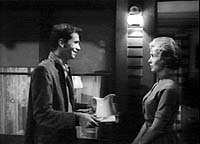 Norman brings Marion her dinner and invites her into his parlor. Notice Norman's reflection in the window. Norman brings Marion her dinner and invites her into his parlor. Notice Norman's reflection in the window.
In the parlor itself, Hitchcock begins his work. The room is small, barely big enough for the two chairs, the lamp table, coffee table, and chest that occupy it. On the lamp table is a Tiffany lamp, the only source of light in the room and thus the key light within the scene. The characters' positions within the room and how they are lit by this single source keys the audience to the characterizations.
Marion, for instance, sits near and slightly behind the lamp. Her face is well lit, and she, like the lamp, appears to radiate a glowing warmth. Despite the fact that she has embezzled forty thousand dollars from her employer, she is not hidden in shadows of evil or consumed by the darker side of her nature. Leaving Marion in light indicates that redemption and atonement is possible. Indeed, at the conclusion of the scene, Marion has done an about face. While Norman does not know the details of her flight, the audience knows she intends to return the stolen money. Marion is also pooled in fill and high key lighting that creates a softness around her and suggests she is redeemable.
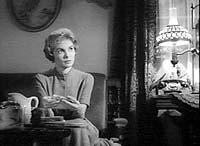
Marion is surrounded by soft lighting. Note the round picture frame on the wall behind her. |
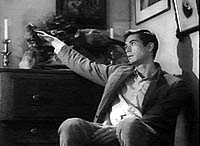
Norman is harshly lit in a corner of the room. Note the angular picture frames behind him.
|
On the other hand, Hitchcock positions Norman far from the light source and slightly to one side. The effect is a harsh line--light and shadow--across Norman's face, re-emphasizing the clash of his dual personality (host/murderer, man/child, mother/son). Norman is also immersed in low key lighting. The result is an unnatural starkness that indicates something is hidden. Back lighting and fill lighting are kept to a minimum, resulting in sharp, angular shadows cast ominously on the wall and ceiling above Norman.
Hitchcock also deftly uses camera angles to reveal all the audience needs to know about the troubled mind of Norman Bates. As he did with the lighting, Hitchcock shapes the scene in terms of contrasts. We see Marion sitting comfortably in her chair, leaning slightly forward, enjoying a sandwich Norman has made for her. Hitchcock places the camera near eye level so the audience sees Marion as two people might see each other while sitting and talking. There is nothing unusual in this. In fact, this particular angle provides the audience with a sense of normalcy and comfort in Marion's presence. Hitchcock, however, moves out of the comfort zone to shoot Norman from an unnaturally low perspective. These two camera angles in-and-of themselves mean nothing. Only when they are juxtaposed can any meaning be taken. The shift to Norman's angle suggests that Norman's world is skewed, off balance, out of kilter. We feel uncomfortable in this position because we are not used to viewing the world from such an angle and to do so makes it difficult to extract meaning.
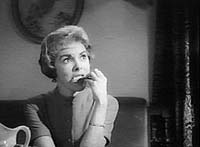
In Norman's parlor, we usually see Marion from the front, so her full face is in view. |
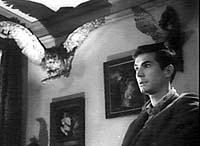
However, the camera frequently moves to the left side of Norman, obscuring his other side.
|
Hitchcock's mise-en-scene probably does more to capture the intent of the characters than any one element in the entire scene. It also emphasizes the duality that exists not only within Norman Bates but within all of us. For instance, Marion is surrounded by scenic details that make her a sympathetic character, not without flaw--after all, she did steal forty thousand dollars-- but certainly not one to condemn too harshly. She sits at ease in her chair. In front of her is a tray with a small meal prepared by Norman. On the tray is a pitcher of milk--not just a glass but an entire pitcher. The detail has less to do with the quantity of milk (Marion, in fact, drinks none of it) as it does with the pitcher itself. This pitcher is white and has soft, graceful lines that suggest Marion's essential goodness. Behind and above her, the curved lines are repeated in a picture frame, and to screen right is the Tiffany lamp with its rounded shade glowing warm and alive. The walls behind her are likewise soft, brightly lit. Marion, especially with the light color of her dress, the curves in her hairstyle and her posture, adds to the sense that she is, or eventually will be, the victim.
Like the camera angles, the "picture" of Marion in the parlor, has little significance until it contrasted with the image of Norman who sits opposite her. Like Marion, details that surround Norman suggest his true nature. Unlike Marion, Norman is immersed in straight lines, many of which are set at angles that create a sense of conflict rather than curved line harmony. While the curves of the milk pitcher help to frame the foreground of Marion, Norman's arms rest on his legs while he nervously interlaces his fingers. To screen left and behind Norman's right shoulder stands a chest with straight heavy lines, a contrast to the curved shade of the Tiffany. On the walls hang small framed pictures, but these pictures have straight frames, and while Marion is bathed in light, Norman wears dark clothing and, because of the lighting, casts long shadows that strike the walls and ceiling sharply like black blades slicing through the air.
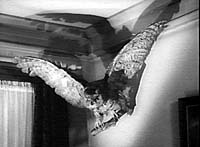 But perhaps the most unusual and the most curious feature of this parlor, and yet the most graphic clue to the twisted mind of Norman Bates, is the stuffed birds mounted on the walls and standing on the table and chest. "I like to stuff things," Norman says, his meaning all too obvious at the end of the film. Moreover, the birds present a rather frightening image in the parlor, as they hover around Norman like dark, sinister angels. But perhaps the most unusual and the most curious feature of this parlor, and yet the most graphic clue to the twisted mind of Norman Bates, is the stuffed birds mounted on the walls and standing on the table and chest. "I like to stuff things," Norman says, his meaning all too obvious at the end of the film. Moreover, the birds present a rather frightening image in the parlor, as they hover around Norman like dark, sinister angels.
Throughout the film, snippets of the dual nature of humanity present themselves, and throughout the film, lighting, camera angle and mise-en-scene make their contributions to the total concept. Their presence in the movie is consistent and each shift is justifiable, yet nowhere in the film do these three elements come together with greater effect and with greater contrast than in Norman's parlor. The scene becomes like Hitchcock himself who hides in plain sight within his own films. Our fun is looking for what lies in front of us. Hitchcock's fun is hiding it from us.
Photo credits: MCA Home Video.
|





